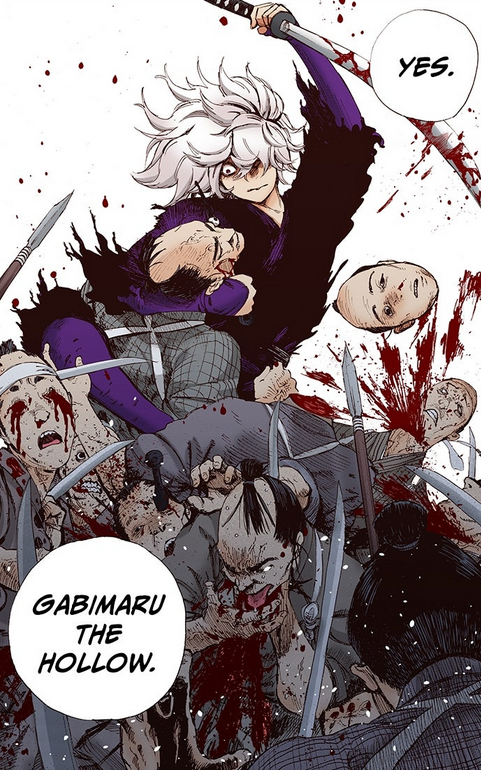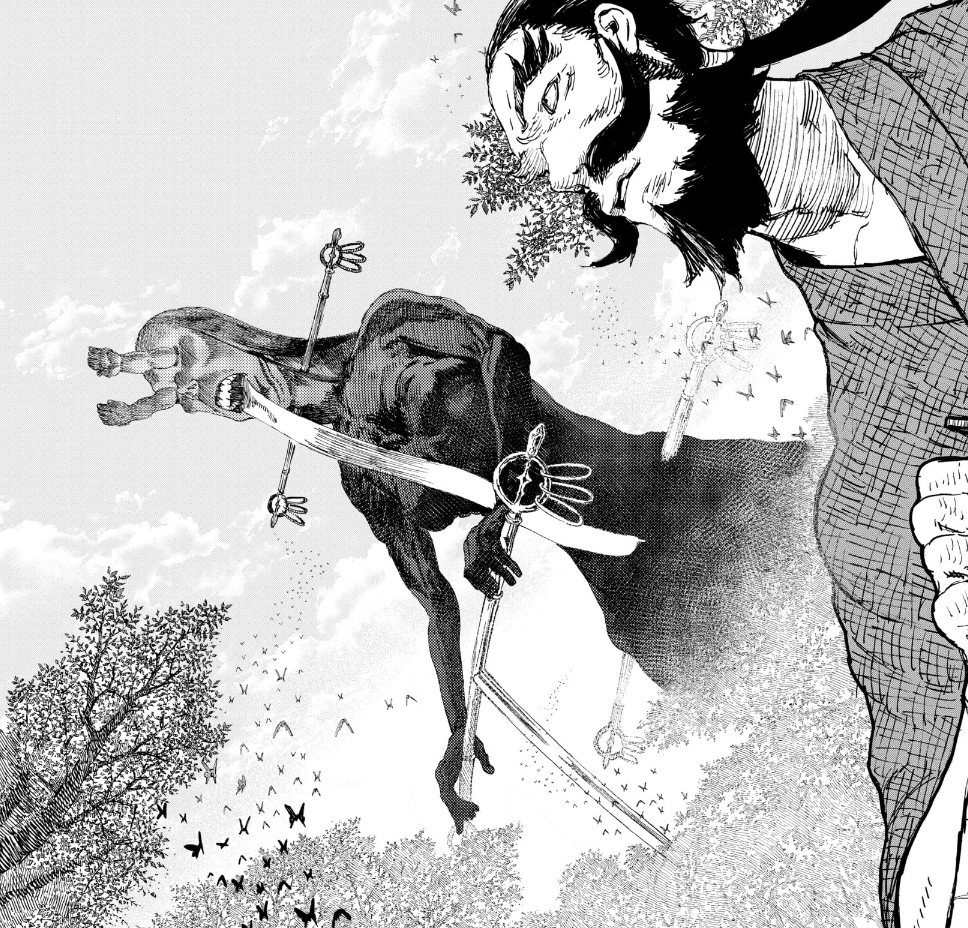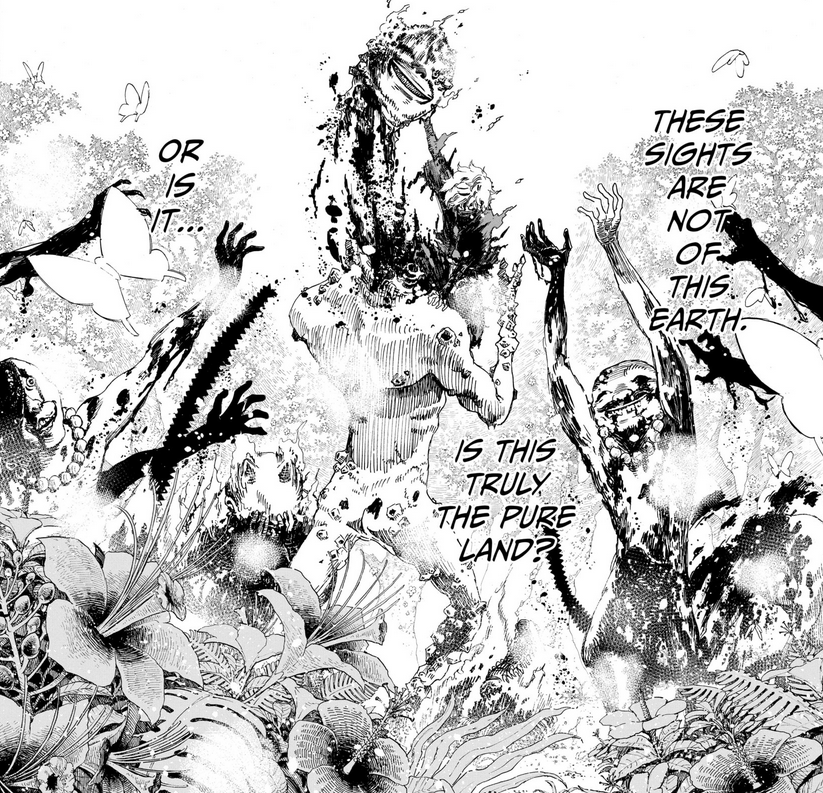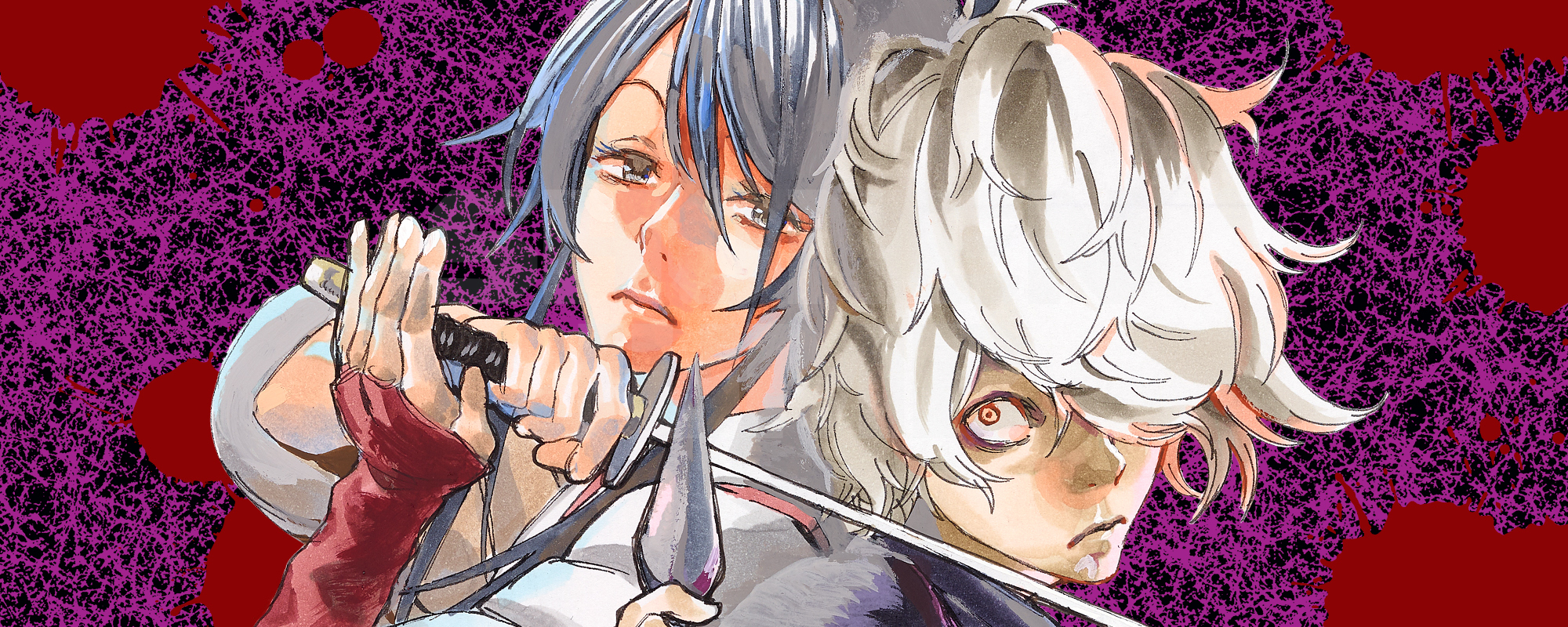Welcome to IXAY ( I X’d a Y ) where Y is a noun and X is a verb. Is that confusing? Yes? Oh…
For this, the very first entry, I Read a Manga: Jigokuraku (地獄楽) localized as Hell’s Paradise: Jigokuraku or just Hell’s Paradise.

Japanese notes
I use a contemporary unofficial romanization style: “ou” for long “o” sounds, “ei” for long “e” sounds etc. It’s the same as writing ō or ē, oo or ee. Don’t let it confuse you, and try not to let it bother you if you prefer a different style. I also always use the native name ordering for individuals’ names (eg Miyazaki Hayao).
Aside on Shounen
“Shounen manga” are, technically speaking, any manga that were published in a shounen-focused distribution. The name refers to young boys, made up of the kanji for “few/small” and “years/age” (少年). “Young” here means anywhere after infancy but before adulthood (roughly from 5-7 up to 18-20). In the west (especially, though also in Japan to a lesser extent), the term is also used to loosely categorize manga based on common tropes. There are merits and flaws in this practice. Pokémon, Death Note, Doraemon, and Chainsaw Man are all shounen, but vary wildly in their tone, content, and themes. It’s when you start comparing titles like Naruto, Bleach, Dragon Ball Z, Boku no Hero Academia, Demon Slayer, Jujutsu Kaisen, and so on that you begin to understand why they get grouped together.
Content Warning: Stylized violence and gore, some discussion about sexual assault.
Spoiler Warning: Some details from early in the manga (up to about chapter six), and non-specific details from then out. If you like, you can also read the first three chapters for free in full color on Naver Webtoons (not an affiliate).
These days, well into my thirties, I tend to avoid shounen manga. I’ve heard that the animation in many of the recent series like Jujutsu Kaisen is great, but I can’t work up the interest. I prefer reading manga to watching anime in the first place. I’ve also got something of a personal rule: I don’t engage with something until it’s complete. I don’t watch TV series that are ongoing, I avoid “early access” video games, I won’t even play FF7 remake games until they’re all out, and I don’t read manga that haven’t ended.
My reasoning is simple: I’ve been burned too many times. Games that remain buggy and/or incomplete for years, TV series in which later seasons retroactively ruin everything with how bad they are, and manga that get discontinued or seriously decline in quality. You might argue: “It’s about the journey, not the destination.” I think it’s about both. Besides, if the second half of the trip ends with me getting food poisoning or having to turn around and go home when I was halfway there, I’d just rather stay home.
Jujutsu Kaisen and Kimetsu no Yaiba are both complete, but I’ve still never heard anything about them that particularly piqued my interest as they seemed fairly typical (though they are relatively short, so they’ve got that going for them, which is nice).
Jigokuraku seemed different, centering around an assassin with a long and successful career even before you turn the first page. I’m not one to entirely dismiss manga simply due to what demographic it’s intended for, so I gave it a shot. Manga series tend to get a bump in popularity on sites like MyAnimeList and MangaUpdates following an anime adaptation, which Jigokuraku received in 2023, so that’s likely how I managed to stumble across it. I finished over the course of about a week, and it was… fine.

We open on the day of our protagonist, Gabimaru’s, execution. Gabimaru’s obviously not an Average Joe (or Yamada Taro if you will), as none of the methods attempted seem to work. He initially claims not to be resisting, but a special executioner who is capable of ensuring death without fail bearing the title Yamada Asaemon determines over the course of several interviews that this is not the case. As it turns out, Gabimaru does not particularly value his own life, but he does have something he finds worth living for. He has a wife back home. Luckily, the Yamada Asaemon, Sagiri, was not sent to ensure a successful execution, but was instead sent to search for skilled fighters with a strong will to live. The Shougun is planning an expedition to a mysterious island in search for the elixir of immortality. All of the soldiers he’d sent before returned with flowers growing out of them, in a sort of vegetative state, hence his need for exceptionally strong individuals. The strongest criminals around, Gabimaru among them, are gathered and offered salvation: a single pardon to whoever returns to Japan with the elixir.

This mysterious island will be the stage for the manga, and from here on it becomes a game of survival. Only one pardon being offered creates a Battle Royale type of situation among the criminals. Each criminal is also assigned a Yamada Asaemon to ensure they do not attempt to flee. The situation swiftly descends into chaos. Rules have no real meaning on the island, where survival is paramount. We’re soon met with surreal imagery: massive, bizarre, humanoid creatures that are composed of strange mixtures of different religious iconographies, butterflies with human faces, and flowers and plants not seen anywhere else. This is the core of Jigokuraku and where it gets its name.

Like many of its shounen contemporaries, Jigokuraku’s strongest moments are front-loaded. The peak of the manga for me really was here at the beginning after arriving on the island. The mangaka, Kaku Yuuji does a good job in particular on the creature designs and backgrounds. The surreal threats reminded me somewhat of Shingeki no Kyoujin, but particularly of Gantz, which I seem to remember also had dangerous enemies in the form of Japanese religious iconography and over-the-top violence. Like Gantz, we’ll also soon realize Yuuji doesn’t shy away from the deaths of major characters.
Unfortunately, Jigokuraku doesn’t spend much time at the height of this tension. These seemingly insurmountable colossi are summarily dismembered by Gabimaru and Sagiri, and the tension of an island inhabited with unbeatable opponents is released like air in a vacuum. The story quickly moves on to a new kind of enemy. The overarching mystery feels like a single loose thread, and the tapestry feels like it’s being woven in real time as Yuuji figures out what he wants to do with the plot as it goes along.

There was an allusion to SA around midway through the manga that had me deeply contemplating whether or not I should drop the series entirely. I ultimately chose to continue, as I was able to interpret the act in question not as something that had taken place, but something that might take place. I still resented its presence, and it felt entirely unnecessary. If you are sensitive to such things, although it does not take place directly within the story, you might consider avoiding this manga entirely.
That’s about as provocative as Jigokuraku ever got, and that moment was not provocative in its favor. Ultimately, I don’t regret reading it, but I don’t think I’ll ever think much about it again.
If all you need to sustain you is decent action, characters, and visuals, then Jigokuraku can provide. If you need anything substantial you’ll be going hungry here.

